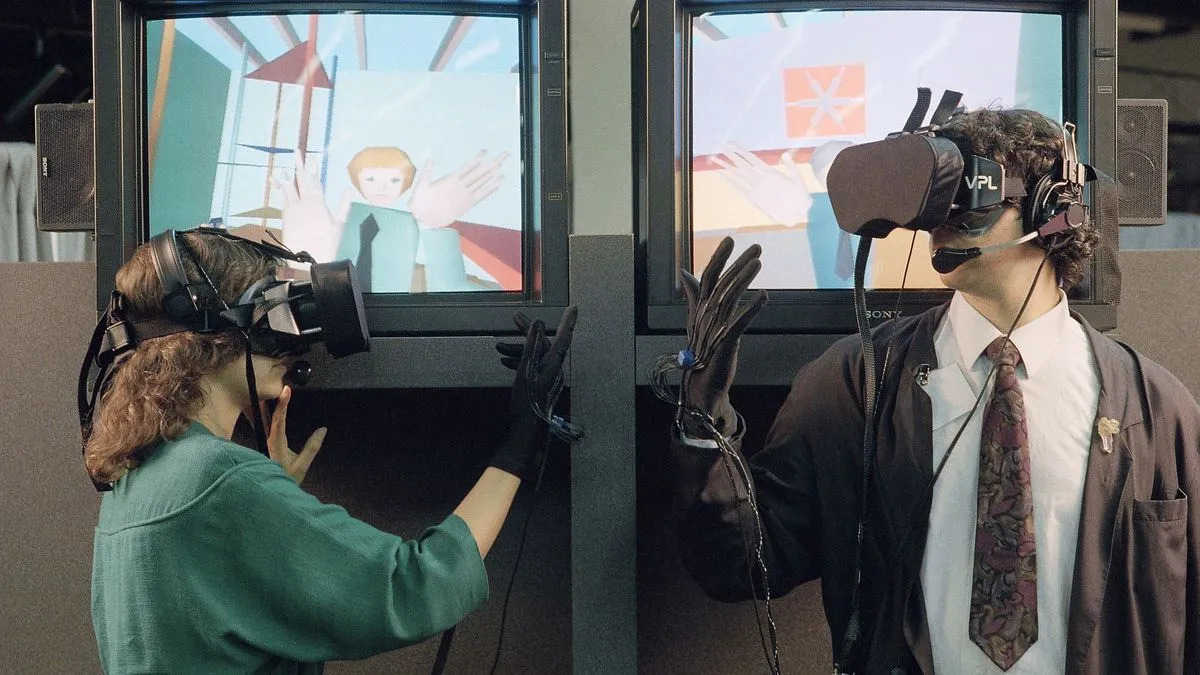Introduction
Welcome to the fascinating world of virtual reality (VR). With rapid advancements in technology, VR has emerged as a revolutionary force, transforming the way we experience and interact with the digital realm. This immersive technology has the potential to revolutionize various industries, from gaming and entertainment to healthcare and education.
Investing in virtual reality offers a unique opportunity to participate in the growth and development of this promising sector. As the demand for VR experiences continues to rise, savvy investors are keen to explore the potential financial gains that investing in virtual reality can offer.
In this article, we will delve into the exciting realm of virtual reality and explore the various ways you can invest in this booming industry. Whether you are a tech enthusiast or a seasoned investor looking for new and profitable opportunities, understanding the world of VR investing is essential.
Before we dive into the investment strategies, it is important to have a basic understanding of what virtual reality is and how it works.
Virtual reality is a technology that transports users into a computer-generated simulated environment, replicating a real or imagined world and simulating a user’s physical presence and sensory experiences within that environment. By wearing a VR headset, users are fully immersed in a virtual world, allowing them to interact with objects, people, and surroundings as if they were truly there.
The potential applications of virtual reality are vast and varied. From gaming and entertainment to training simulations, virtual tours, and even therapeutic experiences, VR has the power to enhance and revolutionize numerous industries. As the technology continues to evolve and improve, its impact on society and the economy is expected to grow exponentially.
Now that we have a basic understanding of what virtual reality is, let’s explore the exciting benefits of investing in this groundbreaking technology.
Understanding Virtual Reality
Virtual reality (VR) is a computer-generated technology that simulates a realistic and immersive experience for users. It replicates an environment that can be based on the real world or completely imaginary. By using specialized VR hardware, such as headsets and controllers, users can interact with and navigate through these virtual environments in a highly engaging and interactive manner.
At the core of virtual reality is the concept of presence, which refers to the feeling of being physically present in the virtual environment. This is achieved through a combination of visual, auditory, and sometimes even haptic (touch) stimuli that create a sense of immersion. The visual element is typically delivered through a head-mounted display (HMD) that provides a 360-degree field of view and tracks the user’s head movements to update the perspective in real-time.
Virtual reality has advanced significantly in recent years, thanks to the advancements in computer graphics, processing power, and motion tracking technology. These developments have resulted in more realistic and believable virtual experiences. Whether it’s exploring a virtual version of ancient Rome, battling zombies in a post-apocalyptic world, or experiencing a roller coaster ride from the comfort of your living room, virtual reality has the potential to transport users to entirely new worlds and unlock unique experiences.
One of the main advantages of virtual reality is its ability to create highly immersive and interactive simulations. This makes it an ideal tool for various industries, including gaming, entertainment, education, healthcare, architecture, and more. In the gaming industry, for example, virtual reality allows players to be fully absorbed in the virtual environment, providing a more engaging and intense gaming experience.
Virtual reality is also being leveraged in the field of healthcare for training medical professionals, simulating surgeries, and even helping patients manage pain and anxiety. In education, virtual reality offers opportunities for interactive and dynamic learning experiences, enabling students to explore historical events, visit faraway places, and engage in hands-on experiments.
As the technology continues to evolve, virtual reality is expected to become more accessible and mainstream. The growing availability of affordable VR hardware, coupled with the increasing number of VR applications and content, is driving adoption and fueling the demand for virtual reality experiences.
In the next section, we will explore the benefits of investing in virtual reality and why it presents an exciting opportunity for investors.
Benefits of Investing in Virtual Reality
Investing in virtual reality (VR) can offer a range of benefits for individuals looking to diversify their portfolio and tap into the potential of this rapidly growing industry. Here are some key advantages of investing in VR:
1. High Growth Potential: The virtual reality market is projected to experience substantial growth in the coming years. With advancements in technology and increasing adoption across various sectors, such as gaming, entertainment, and healthcare, the demand for VR experiences is expected to skyrocket. By investing early in this burgeoning industry, investors have the opportunity to capitalize on its potential for significant financial returns.
2. Disruptive Technology: Virtual reality has the potential to disrupt multiple industries by transforming the way we interact, learn, and conduct business. As the technology becomes more advanced and accessible, it is likely to revolutionize areas such as gaming, real estate, education, travel, and more. Investing in VR allows individuals to be part of this technological revolution and potentially benefit from its disruptive impact.
3. Increasing Adoption: Virtual reality is no longer confined to niche enthusiasts or early adopters. It is gaining broader acceptance and adoption among mainstream consumers. From VR gaming experiences to immersive training simulations and virtual meetings, the applications of VR are expanding rapidly. As more people embrace virtual reality, the market potential and investment opportunities continue to grow.
4. Diversification: Investing in virtual reality provides an opportunity to diversify your investment portfolio. By allocating a portion of your investments to emerging technologies like VR, you can mitigate risks and potentially enjoy higher returns. Virtual reality operates in a different industry than traditional investments, such as stocks or real estate, allowing you to spread your risk across different sectors.
5. Early-mover Advantage: Investing in virtual reality at this stage allows you to gain an early-mover advantage. As the technology continues to evolve and mature, being an early investor can position you to benefit from the growth of VR companies, platforms, and applications. By identifying promising startups and established players in the VR space, you can potentially secure a competitive advantage when the market reaches full potential.
6. Innovation and Creativity: Virtual reality is a hub of innovation and creativity. Investing in this technology offers the opportunity not only to financially support innovative companies and startups but also to be part of the discovery and development of groundbreaking VR applications. Supporting the evolution of virtual reality can contribute to shaping the future of entertainment, communication, and many other industries.
7. Long-term Investment: Virtual reality is here to stay. As the technology continues to advance and become increasingly integrated into various aspects of our lives, the long-term investment potential is significant. By investing in virtual reality, you can position yourself for long-term growth and potentially reap ongoing benefits as the market expands and matures.
It is important to note that investing in virtual reality, like any investment, comes with inherent risks. In the next section, we will explore the different ways you can invest in virtual reality and consider the risks and challenges associated with each approach.
Ways to Invest in Virtual Reality
There are several ways for investors to get involved in the virtual reality (VR) industry and capitalize on its immense potential. Here are five key approaches to consider when investing in virtual reality:
1. Investing in Virtual Reality Stocks: One option is to invest directly in companies that are involved in the development, production, or distribution of virtual reality technology and content. This can include hardware manufacturers, software developers, gaming studios, or even established tech giants that have a focus on VR. Researching and selecting individual stocks in the virtual reality sector allows investors to potentially benefit from the growth and success of specific companies in this space.
2. Investing in Virtual Reality Funds or ETFs: For individuals who prefer a more diversified approach, investing in virtual reality mutual funds or exchange-traded funds (ETFs) can be a strategic choice. These funds typically consist of a portfolio of stocks from multiple companies involved in virtual reality. By investing in a fund or ETF, investors gain exposure to a broader range of companies within the virtual reality industry, spreading their risk across various players in the market.
3. Investing in Virtual Reality Startups: Another avenue to consider is investing in early-stage startups that are focused on virtual reality development. This option allows investors to potentially find the next big VR success story while supporting innovative entrepreneurs. However, investing in startups comes with a higher level of risk, as the majority of startups fail. Thorough due diligence and analysis of the startup’s business model, team, and market potential are crucial before making an investment.
4. Investing in Virtual Reality Gaming Platforms: Gaming is one of the most prominent and lucrative sectors in the VR industry. Investing in virtual reality gaming platforms or companies that produce VR games can be a strategic choice for those who believe in the growth of the gaming industry. From immersive multiplayer experiences to virtual reality arcades, the gaming sector within VR offers significant investment opportunities.
5. Investing in Virtual Reality Real Estate: Virtual reality has the potential to transform the real estate industry by allowing users to view properties remotely through virtual tours. Investing in virtual reality real estate companies or platforms that provide VR property tours can be a unique way to tap into the real estate market through the lens of virtual reality technology.
Each investment approach has its own considerations and risks. It is important to conduct thorough research, assess the market trends, and consult with a financial advisor before making any investment decisions in the virtual reality sector. Additionally, staying up to date with the latest developments and innovations in virtual reality can provide valuable insights for potential investment opportunities.
In the next section, we will explore the risks and challenges associated with investing in virtual reality, helping you make informed investment decisions in this exciting and dynamic industry.
Investing in Virtual Reality Stocks
Investing in virtual reality (VR) stocks provides an opportunity for investors to directly participate in the growth and success of companies involved in the virtual reality industry. Here are some key considerations when investing in virtual reality stocks:
Researching and Selecting Companies: Start by researching and identifying companies that are at the forefront of virtual reality technology. Look for hardware manufacturers, software developers, or content creators that have a strong foothold in the VR market. Consider factors such as their financial performance, product portfolio, market share, and competitive advantages.
Diversification: Diversify your portfolio by investing in a variety of virtual reality stocks. This strategy helps spread out risk and increases the chance of benefiting from the success of multiple companies rather than relying on the performance of a single stock.
Industry Trends and Market Potential: Stay informed about the latest industry trends and market forecasts for the virtual reality sector. Understand the potential growth opportunities and identify companies that align with those trends. Factors to consider include the rate of VR adoption, the demand for VR content, and the emerging applications of VR technology across different industries.
Financial Performance: Evaluate the financial health and performance of the companies you are considering investing in. Look at factors such as revenue growth, profitability, and debt levels. It’s also important to assess the company’s ability to remain competitive and innovate in the fast-paced VR industry.
Long-Term vs. Short-Term Investment: Determine your investment goals and time horizon. Investing in virtual reality stocks can be a long-term strategy to benefit from the continued growth of the VR industry. However, short-term trading strategies based on market trends and news can also be pursued, but they typically carry higher risks.
Monitoring and Managing Investments: Regularly monitor the performance of the virtual reality stocks in your portfolio. Stay updated on company news, product releases, and market developments that may impact your investments. Adjust your investment strategy as needed to reflect changing market conditions.
It’s worth noting that investing in individual stocks carries risks. Factors such as market volatility, competition, technological advancements, and regulatory changes can affect the performance of virtual reality stocks. Therefore, it’s important to conduct thorough research, diversify your portfolio, and consult with a financial advisor who specializes in the virtual reality sector.
Investing in virtual reality stocks can be an exciting way to participate in the growth of this transformative technology. However, it’s crucial to approach it with a well-informed and balanced investment strategy to mitigate risks and maximize potential returns.
Investing in Virtual Reality Funds or ETFs
Investing in virtual reality (VR) funds or exchange-traded funds (ETFs) can be an effective way to gain exposure to the virtual reality industry while diversifying your investment portfolio. Here are some key points to consider when investing in virtual reality funds or ETFs:
Portfolio Diversification: Investing in virtual reality funds or ETFs allows you to diversify your investments across a broad range of companies involved in the VR industry. These funds typically consist of a portfolio of stocks from companies engaged in virtual reality hardware, software, gaming, content creation, and more. By investing in a virtual reality fund or ETF, you can access a diversified selection of stocks in the VR sector without the need to individually select and manage each stock.
Access to Expertise: Virtual reality funds and ETFs are managed by professional fund managers who have specialized knowledge and expertise in the virtual reality industry. They conduct research and analysis to identify promising companies within the sector, making investment decisions on behalf of the fund. This allows investors to benefit from the knowledge and experience of industry experts in their investment decisions.
Liquidity and Convenience: Virtual reality funds and ETFs are publicly traded on stock exchanges, providing investors with liquidity and the ability to buy or sell shares on market trading days. This offers flexibility and convenience in managing your virtual reality investments, allowing you to enter and exit positions easily.
Lower Minimum Investment: Investing in virtual reality funds or ETFs often requires a lower minimum investment compared to investing in individual stocks. This makes them accessible to a wider range of investors who may not have the capital to build a diversified portfolio of virtual reality stocks on their own.
Lower Risk and Cost: Investing in virtual reality funds or ETFs can potentially reduce risk compared to investing in individual stocks. The portfolio diversification inherent in these funds spreads the risk across multiple companies within the VR industry. Additionally, the cost associated with investing in virtual reality funds or ETFs may be lower compared to purchasing individual stocks due to lower trading commissions and management fees.
Performance Tracking: Virtual reality funds and ETFs provide transparency in terms of their holdings and performance. Investors can easily track the performance of their investments and compare them to relevant benchmarks. This allows for better monitoring and evaluation of the fund’s performance.
While virtual reality funds and ETFs can offer benefits, it’s important to consider factors such as expense ratios, fund management fees, and the fund’s investment strategy before making an investment decision. Research and compare different funds or ETFs to determine which aligns with your investment goals and risk tolerance.
Investing in virtual reality funds or ETFs can be an efficient and cost-effective way to gain exposure to the VR industry and potentially benefit from its growth. As with any investment, it’s advisable to conduct thorough research, consult with a financial advisor, and consider your own investment objectives and risk profile.
Investing in Virtual Reality Startups
Investing in virtual reality (VR) startups can be an exciting and potentially rewarding way to support innovation in the VR industry while seeking financial returns. Here are some key considerations when investing in virtual reality startups:
Identifying Promising Startups: Start by identifying startups that have a compelling vision, innovative technology, and a strong team with the skills and experience necessary to succeed in the VR market. Research their business model, product or service offering, competitive advantages, and market potential to assess their viability as a startup investment.
Evaluate the Market Potential: Consider the market potential for the VR startup’s product or service. Evaluate the demand for their offering, the size of their target market, and the growth trajectory of the VR industry as a whole. Assessing the startup’s ability to capture a significant share of the market can provide insight into their long-term growth potential.
Thorough Due Diligence: Conduct thorough due diligence on the VR startup before making an investment. Evaluate their financials, growth projections, intellectual property, and competitive landscape. Assess the startup’s track record, reputation, and likelihood of successfully executing their business plan.
Investment Structure: Determine the investment structure that aligns with the startup’s funding needs and your investment goals. Common options include direct equity investments, convertible notes, or participation in venture capital funds that focus on VR startups. Each option has its own considerations, risks, and potential rewards, so it’s important to consult with legal and financial advisors to understand the implications of each investment structure.
Risk and Return Profile: Investing in startups carries inherent risks. Startups often face challenges such as limited operating history, higher failure rates, and market uncertainty. However, investing in VR startups can also offer the potential for substantial returns if successful. It’s important to assess your risk tolerance and carefully consider the potential reward against the risks associated with startup investing.
Investor Involvement: Determine the level of involvement you desire as an investor. Some startups may offer opportunities for investors to actively contribute beyond capital, such as providing expertise, industry connections, or strategic guidance. Assess whether you have the ability and desire to play an active role in assisting the startup’s growth.
Portfolio Diversification: Investing in startups is inherently risky, so it’s important to diversify your investment portfolio to mitigate risks. Consider allocating only a portion of your investment capital to VR startups and diversify across different startups or sectors within the VR industry.
Investing in VR startups can be a high-risk, high-reward strategy. While some startups may achieve extraordinary success, many fail to reach their full potential. Thorough research, due diligence, and a comprehensive understanding of the VR industry are crucial when considering startup investments.
Furthermore, investing in VR startups requires a long-term perspective as the process may involve several years before seeing a return on investment. It’s advisable to consult with experienced professionals, such as venture capital firms or angel investors, to gain insights into the virtual reality startup ecosystem and maximize your chances of making informed investment decisions.
Investing in Virtual Reality Gaming Platforms
Investing in virtual reality (VR) gaming platforms can be a strategic way to capitalize on the growing popularity of virtual reality and the immense potential of the gaming industry. Here are some key points to consider when investing in virtual reality gaming platforms:
Growth of the VR Gaming Market: Virtual reality gaming is gaining significant traction, with a growing number of gamers and increasing demand for immersive gaming experiences. Investing in virtual reality gaming platforms allows investors to tap into this thriving market and potentially benefit from its continued growth.
Selection of VR Gaming Platforms: Research and analyze different virtual reality gaming platforms to identify ones with a strong user base, a diverse range of games and experiences, and a solid reputation. Look for platforms that have a clear vision for the future and a robust development pipeline to ensure sustainable growth.
Business Model: Understand the business model of the virtual reality gaming platform you are considering investing in. Evaluate how they generate revenue, such as through game sales, in-app purchases, subscriptions, or advertising. Assess the platform’s monetization strategies and evaluate their long-term viability.
Competitive Advantage: Consider the competitive landscape of the virtual reality gaming industry and understand the unique selling points and competitive advantages of the platform you are interested in. Factors such as exclusive game titles, partnerships with developers, innovative features, or a strong community can contribute to the platform’s competitive edge.
User Engagement and Retention: Analyze the platform’s user engagement metrics, such as number of active users, frequency of use, and user retention rates. A platform with a large and dedicated user base indicates a strong value proposition and the potential for sustainable growth.
Partnerships and Content Pipeline: Examine the platform’s partnerships with game developers and content creators. A robust content pipeline with a steady stream of high-quality games can attract and retain users, drive platform adoption, and contribute to its long-term success.
Platform Integration and Technology: Assess the platform’s technology infrastructure and integration capabilities. Look for platforms that support multiple VR hardware devices, provide a seamless user experience, and have a strong technical foundation to adapt to evolving technologies and user preferences.
Financial Performance: Evaluate the financial health and performance of the virtual reality gaming platform. Consider factors such as revenue growth, profitability, and the platform’s ability to monetize its user base. Analyze the company’s financial statements, annual reports, and investor presentations to gain insights into its financial standing.
As with any investment, it’s crucial to conduct thorough research, analyze market trends, and seek advice from financial professionals before investing in virtual reality gaming platforms. Consider your investment objectives, risk tolerance, and the potential returns in relation to the risks involved.
Investing in virtual reality gaming platforms offers the opportunity to be part of the immersive gaming revolution and capitalize on the growing demand for virtual reality gaming experiences. By carefully selecting platforms with strong value propositions, competitive advantages, and sustainable growth strategies, investors can position themselves for potential financial growth in this dynamic and ever-evolving industry.
Investing in Virtual Reality Real Estate
Investing in virtual reality (VR) real estate offers a unique opportunity to combine the benefits of the real estate market with the immersive experience of virtual reality technology. Here are some key considerations when investing in virtual reality real estate:
Virtual Property Tours: Virtual reality allows potential buyers and investors to explore properties remotely through immersive virtual tours. Investing in virtual reality real estate platforms or companies that offer VR property tours can provide a unique way to tap into the real estate market. Virtual property tours can enhance the marketing and sales process, attract a broader audience, and potentially increase property visibility and sales.
Property Visualization and Design: Virtual reality can be utilized in the real estate industry for property visualization and design purposes. This technology allows developers, architects, and investors to showcase their vision for a property before it is built. Investing in virtual reality platforms that cater to the visualization and design aspects of real estate can provide opportunities to support innovative projects and potentially benefit from the increased demand for these VR design services.
Virtual Staging: Virtual reality can also be used for virtual staging, where empty or outdated properties are digitally furnished and transformed through VR technology. Investing in virtual reality companies that specialize in virtual staging can offer an innovative solution for property owners, real estate agents, and investors to showcase the potential of a property and attract potential buyers.
Better Decision-Making: Virtual reality provides a more immersive and realistic way to evaluate properties. Potential investors can gain a deeper understanding of a property’s layout, design, and potential by virtually walking through the space. This enhanced visualization can aid in better decision-making and reduce the need for multiple physical property visits, saving time and resources.
Global Market Access: Investing in virtual reality real estate opens up opportunities to invest in properties beyond geographical limitations. Virtual reality can bridge the gap between investors and properties located in different regions or countries. This can be particularly advantageous for international investors who want to diversify their real estate portfolio without the need for extensive travel.
Market Trends and Growth Potential: Monitor market trends and the adoption of virtual reality in the real estate industry. Stay informed about the growth potential and evolving applications of VR in real estate. Understanding how virtual reality is being integrated into property marketing, sales, and design can help identify promising investment opportunities.
As with any investment, it’s important to conduct thorough research, analyze market trends, and seek advice from real estate professionals or financial advisors. Understand the potential risks associated with virtual reality real estate investing, such as technological advancements, market volatility, and regulatory changes. It’s also vital to evaluate the strength and credibility of virtual reality platforms or companies before making any investment decisions.
Investing in virtual reality real estate presents a unique opportunity to leverage technology and innovation to enhance the traditional real estate experience. By considering the potential of virtual property tours, property visualization and design, virtual staging, and the broader market trends, investors can position themselves to benefit from the growing integration of virtual reality in the real estate industry.
Risks and Challenges of Investing in Virtual Reality
While investing in virtual reality (VR) can be an exciting prospect, it’s important to be aware of the risks and challenges associated with this evolving industry. Here are some key considerations:
Market Volatility: The VR industry is still relatively young and can be subject to market volatility. Market conditions, technological advancements, and consumer preferences can all impact the performance of VR investments. Fluctuations in market demand, competition, and the emergence of new technologies can lead to unpredictable shifts in the VR market.
Competition and Disruption: The VR industry is highly competitive, with numerous companies vying for market share. As technology evolves, new entrants and disruptive technologies can quickly change the competitive landscape. Investing in the right companies within this dynamic environment requires careful research and analysis.
Technological Advancements: Virtual reality technology is evolving rapidly, and advancements can render current products or platforms obsolete. Investing in VR requires keeping up with the latest technological trends and understanding the potential impact of new innovations on existing investments. Failure to adapt to evolving technologies can pose risks to VR investments.
Adoption and Consumer Demand: Widespread adoption of VR technology is crucial for its success. While the market for VR is growing, consumer demand is still developing. Uncertain consumer adoption rates and preferences can impact the success of VR investments. Factors such as high hardware costs, limited content availability, and concerns over motion sickness may influence consumer adoption rates.
Regulatory and Legal Factors: As the VR industry grows, regulatory and legal challenges may emerge. Intellectual property rights, licensing, privacy concerns, and content regulations can impact VR investments. Changes in regulations or legal disputes surrounding VR technologies and content can disrupt the industry and affect investment outcomes.
Cost of Development and Content Creation: The cost of developing VR hardware, software, and content can be substantial. Investing in VR companies involved in development and content creation carries the risk of cost overruns, delays, or failure to deliver on expected products or experiences. Quality and engaging content are crucial for driving VR adoption, and investment outcomes can be affected by the ability to produce compelling content.
Consumer Acceptance and Perception: The success of VR relies on widespread consumer acceptance and positive perceptions. Factors such as ease of use, comfort, and demonstrating the value proposition of VR experiences to consumers can impact adoption rates. Negative experiences or perceptions of VR technology can hinder its growth potential and affect investment outcomes.
Limited Market Research: The VR industry is still evolving, and comprehensive market research data may be limited. Accurately predicting market trends, consumer preferences, and industry growth can be challenging. Lack of robust market data can increase the level of uncertainty and risk associated with VR investments.
It’s essential to thoroughly research and analyze potential VR investments, assess the risk-reward ratio, and consult with financial advisors or professionals experienced in the VR industry. Diversifying investments across multiple VR sectors and staying informed about industry trends and advancements can help manage risks associated with investing in virtual reality.
By understanding and carefully considering the risks and challenges involved, investors can make informed investment decisions and potentially capitalize on the exciting opportunities offered by the dynamic and rapidly evolving virtual reality industry.
Conclusion
Investing in virtual reality (VR) presents a unique opportunity to participate in the growth and potential of this transformative technology. By understanding the various ways to invest in VR, such as through stocks, funds/ETFs, startups, gaming platforms, and real estate, investors can diversify their portfolios and tap into the booming VR industry.
Virtual reality has the potential to disrupt multiple sectors, with applications ranging from gaming and entertainment to healthcare, education, and real estate. As technology continues to advance and VR adoption expands, the market potential for VR investments continues to grow.
However, it’s important to be aware of the risks and challenges associated with investing in VR. Market volatility, competition, technological advancements, and consumer adoption rates are factors that can impact the success of VR investments. Thorough research, careful evaluation, and diversification can help manage these risks.
Investing in VR demands staying informed about industry trends, monitoring the performance of investments, and assessing the long-term viability of companies and technologies. Consulting with financial advisors or professionals experienced in the VR industry can provide valuable insights and guidance.
In conclusion, investing in virtual reality offers a unique opportunity to be part of the transformative power of this cutting-edge technology. By making informed investment decisions, investors can potentially benefit financially while supporting the development and growth of the VR industry. As VR continues to evolve and integrate into various aspects of our lives, the opportunities for investment and the potential for future returns are boundless.

























